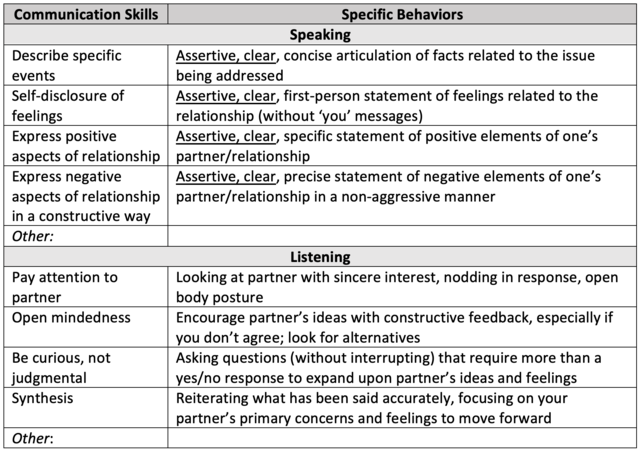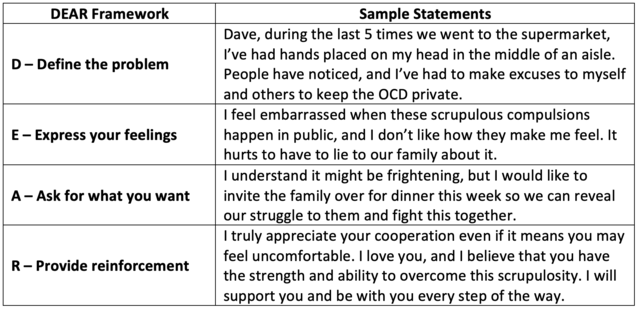Assertiveness
Assertive Communication: Required in All OCD Marriages
How communication can build trust and satisfaction in relationships.
Posted October 8, 2022 Reviewed by Vanessa Lancaster
Key points
- Trust is a key element of good communication in relationships. It transcends actions, discussions, and behaviors.
- Partners must value themselves and each other to improve the quality of communication in the marriage.
- Couples who work on having each partner’s voice expressed and received in a safe space will likely enjoy more effective communication.
Have you ever felt unheard in your marriage? Does your partner merely think about what they’ll say next instead of actively listening to your ideas and feelings? Do you feel accused when you have a disagreement with your spouse? These are some indications that you can improve communication in your relationship.
This post examines three principal elements of effective, assertive communication in marriages affected by obsessive-compulsive disorder (OCD): building trust, communication skills and behaviors, and action plans.
Building Trust in Relationships
Trust is your inherent confidence in your partner (Covey, 2006). It transcends actions, discussions, and behaviors. Think of a low-trust relationship you have had or observed. The partners likely often disagreed, even with well-organized arguments or well-meaning sentiments. Contrarily, a trusted spouse will likely understand you when you are unclear or misspeak. In trusting relationships, partners give each other a margin of error, a moment of grace.
In addition to trust, the intent to improve a relationship is necessary for constructive communication. Well-researched variables such as nonverbal cues are important in communication, but partners must want to communicate well to communicate effectively. “Simply teaching people to lean forward or to maintain eye contact is, in my experience, less effective than trying to get the partners to value listening to each other” (Halford, 2001, p. 244). In other words, partners must value themselves and each other to improve the quality of communication in the marriage.
Communication Skills and Behaviors
One experienced couple’s therapist broke communication skills into speaking and listening skills. He suggested that couples can discern what they need to work on during therapy and at home by reviewing a list of skills and behaviors. The table below is adapted from Halford’s (2001) taxonomy and includes some attributes from my experience while allowing space for a couple to identify their skills and behaviors:

Do you notice a pattern? The attributes "assertive" and "clear" are key elements in many effective communication-related behaviors. Couples who deliberately work on having each partner’s voice expressed and received in a safe space will likely enjoy more effective communication in their relationships.
Action Plans for Assertive Communication
So, what can you do to improve communication in your marriage? Once you better understand the context of trust and the skills and/or behaviors that affect the quality of communication, setting up an action plan is a viable next step. An action plan is an agreement, usually written but not necessarily, of specific attitudes and behaviors both partners choose to employ to improve some aspect of their relationship. It could involve tracking unwanted behaviors to become more mindful of them, or it could consist of a list of meditative practices you want to try to help manage stress triggers.
In our marriage, we have used action plans to address specific issues that drain the effectiveness of our trust and, therefore, the quality of our communication. For instance, we developed an action plan to manage my religious ritual compulsions, which manifested in me placing hands on my wife’s head to somehow "bless" her spontaneously–in the middle of supermarket aisles and other public places.
While not a violent act, it certainly was embarrassing. My OCD prevented me from perceiving my wife’s shame and frustration. After some therapy and coaching, we developed an action plan to mitigate this public scrupulosity by using multiple pathways to identify challenges, opportunities, and strategies (Culkin & Culkin, 2021, table 14.1).
As a result of working together to cope with the issue through effective communication using the structured technique of an action plan, I no longer engage this misplaced scrupulosity.
To reiterate, employing an assertive style that allowed each partner to express his/her ideas and feelings has enhanced the effectiveness of our communications when developing our marriage.
In this context, an assertive communication (as opposed to passive, aggressive, or passive-aggressive) style involves respecting your partner while standing up for yourself through active listening, clearly and civilly expressing your feelings and ideas, and “taking a stand when you disagree” (Abramowitz, 2021).
It presumes each partner implicitly trusts the other to do what’s best for the relationship. The DEAR technique provides a simple structure that facilitates assertive communication while using key skills and behaviors to highlight positive "I"–rather than confrontational "you"–statements (Abramowitz, 2021). Using the previous action plan as a template, a sample discourse could look something like Abramowitz's DEAR framework (see image).

Conclusion
Focusing on effective, assertive communication elements can help your marriage develop. Building trust establishes a foundation upon which partners can work on constructive skills and behaviors that can support action plans that result in higher degrees of assertive communication in a marriage. How’s the communication in your marriage?
References
Abramowitz, J. S. (2021). The Family Guide to Getting Over OCD: Reclaim Your Life and Help Your Loved One. The Guilford Press. See pp. 91-92 for more details of the DEAR Method.
Covey, S. M. R. (2006). The Speed of Trust: The One Thing That Changes Everything. Free Press.
Culkin, D. T., & Culkin, M. A. (2021). OCD and Marriage: Pathways to Reshaping Your Lives Together. Specialty Press, Inc. https://ocdandmarriage.com
Halford, W. K. (2001). Brief Therapy for Couples: Helping Partners Help Themselves. The Guilford Press.




